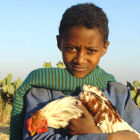The National Health Service, Food Safety and Food Quality (SENASICA)
confirmed, following a series of molecular diagnostic tests, the presence of
avian influenza type A, subtype H7N3, in poultry farms and municipalities
Tepatitlán Acatic, which does not affects humans, only birds, according to the
World Organization for Animal Health (OIE).
In this situation, the SENASICA reported that in order to diagnose,
prevent, control and eradicate the virus activated the National Emergency Animal
Health covering, home, review of farms in the region where the first cases of
this type of highly pathogenic influenza, exotic to Mexico.
The H7N3 avian influenza virus poses no risk to the consumption of
poultry and containment measures to be applied are intended to protect the
production of this area.
The health measures provide for the control of the movement, to prevent
the affected birds, poultry, offal and manure are transferred to regions without
the presence of the virus.
Para ello, se
dispondrá de cordones zoosanitarios. For this purpose, beads have animal
health.
It is also considered immunization prior permission from the SENASICA,
to protect and prevent the spread of the disease and quarantine and isolation of
affected farms. Even be eradicated poultry products and byproducts
in the terms determined by the body.
Other health measures are the practices of sanitation, disinfection,
sterilization, using germicides and pesticides in animals, premises and
transport to prevent transmission to farms and uninfected birds.
This process is expected to attend technical and reference laboratories
of the National Diagnostic Services in Animal Health (CENASA) and the National
Service Center for Animal Health Certification (CENAPA) SENASICA.
It also asked the producers increase biosecurity measures and report to
health authorities when they detect suspected cases of infection by the
virus. This will help control and eradication of the disease and
protect the poultry industry.
Symptoms that may have chickens, turkeys and other birds, are: sudden
drop in egg production, soft shelled egg, depression and decay, reduction in
consumption of food, overcrowding of birds and ruffled feathers; bloody nasal
discharge, blue and purple chin crest swollen head, eyelids, comb, wattles and
legs, and diarrhea and death.
SENASICA certify, through laboratory tests, that the farms that sell
eggs and poultry meat for human consumption are healthy as marking the
international animal health standards.
Finally, it was reported that, based on international protocols
followed in these cases, the SENASICA notified the OIE of the presence of this
disease and the measures taken to eradicate it.
For further information or reports, contact the Mexico-United States
for the Prevention of Foot and Mouth Disease and Other Exotic Diseases of
Animals: Toll free, 01 800 75 1210 0;
Phone: (55) 52593035, 52591441 and 36180821 to 30 ;
(55) 59051000 Ext. 51234, 51236, 51241 and 51242.
También vía
correo electrónico a: iromero@senasica.gob.mx;
julio.garcia@senasica.gob.mx; juan.acevedo@senasica.gob.mx
, informó SENASICA. http://translate.google.com/translate?sl=auto&tl=en&js=n&prev=_t&hl=en&ie=UTF-8&layout=2&eotf=1&u=http%3A%2F%2Fwww.sagarpa.gob.mx%2Fsaladeprensa%2Fboletines2%2FPaginas%2Fdefault.aspx
http://translate.google.com/translate?sl=auto&tl=en&js=n&prev=_t&hl=en&ie=UTF-8&layout=2&eotf=1&u=http%3A%2F%2Fwww.sagarpa.gob.mx%2Fsaladeprensa%2Fboletines2%2FPaginas%2Fdefault.aspx


 Continued health fence in the area of Jalisco Tepatitlan
Continued health fence in the area of Jalisco Tepatitlan



